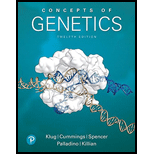
Concept explainers
In a family with one autistic child the risk for another affected child is approximately 25 percent. This is the same level of risk that a couple who are each heterozygous for a recessive allele will have an affected child. What are the similarities and differences in these two situations?
To determine: The similarities and differences between the cases-one autistic child in family raising the 25 % risk for another to develop autism and the heterozygous couple having an affected child.
Introduction: Autism is a severe developmental disorder in which the individual has impaired communication. The person faces challenges with social interaction, has obsessive interests and repetitive behaviors. The family which has one autistic child, the risk for another affected child gets raised by 25%. This is considered the same level of risk that a couple, both heterozygous for the recessive allele would have as they give rise to an affected child.
Explanation of Solution
The similarity between the two situations is that both of them give rise to autism affected individual. The development of autism can be both genetic and environmental. In the case, where the presence of one autistic child in the family raises the risk by 25% for the second child to be affected with the disease, shows the environmental causes of the disorder. On the other hand, the presence of two heterozygous (for recessive allele) parents to produce an affected child, shows the genetic cause of disease.
The differences between the two situations are as follows:
| No. | Characteristics | A family with already an autistic child | A couple heterozygous for recessive allele |
| 1. | Cause of disease | The probability of the second child to have the disease shows the non-genetic cause of disease. | The probability of a child to develop autism from heterozygous parents shows a genetic form of the disease. |
| 2. | Proposed mechanism for development of disease | The nongenetic cause of autism is neuroinflammation, where there is an abnormality in the white matter. The white matter acts as a wiring tissue for connecting areas of the brain. | The genetic cause of autism occurs when both the parents have one recessive allele for the disease. As a result, when an individual has the presence of both the recessive alleles, autism is developed. |
Want to see more full solutions like this?
Chapter 5 Solutions
EBK CONCEPTS OF GENETICS
Additional Science Textbook Solutions
Cosmic Perspective Fundamentals
Biology: Life on Earth (11th Edition)
Human Anatomy & Physiology (2nd Edition)
Microbiology: An Introduction
Campbell Biology: Concepts & Connections (9th Edition)
Organic Chemistry (8th Edition)
- 12. Calculate the area of a circle which has a radius of 1200 μm. Give your answer in mm² in scientific notation with the correct number of significant figures.arrow_forwardDescribe the image quality of the B.megaterium at 1000X before adding oil? What does adding oil do to the quality of the image?arrow_forwardWhich of the follwowing cells from this lab do you expect to have a nucleus and why or why not? Ceratium, Bacillus megaterium and Cheek epithelial cells?arrow_forward
- 14. If you determine there to be debris on your ocular lens, explain what is the best way to clean it off without damaging the lens?arrow_forward11. Write a simple formula for converting mm to μm when the number of mm's is known. Use the variable X to represent the number of mm's in your formula.arrow_forward13. When a smear containing cells is dried, the cells shrink due to the loss of water. What technique could you use to visualize and measure living cells without heat-fixing them? Hint: you did this technique in part I.arrow_forward
- 10. Write a simple formula for converting μm to mm when the number of μm's are known. Use the variable X to represent the number of um's in your formula.arrow_forward8. How many μm² is in one cm²; express the result in scientific notation. Show your calculations. 1 cm = 10 mm; 1 mm = 1000 μmarrow_forwardFind the dental formula and enter it in the following format: I3/3 C1/1 P4/4 M2/3 = 42 (this is not the correct number, just the correct format) Please be aware: the upper jaw is intact (all teeth are present). The bottom jaw/mandible is not intact. The front teeth should include 6 total rectangular teeth (3 on each side) and 2 total large triangular teeth (1 on each side).arrow_forward
- Answer iarrow_forwardAnswerarrow_forwardcalculate the questions showing the solution including variables,unit and equations all the questiosn below using the data a) B1, b) B2, c) hybrid rate constant (1) d) hybrid rate constant (2) e) t1/2,dist f) t1/2,elim g) k10 h) k12 i) k21 j) initial concentration (C0) k) central compartment volume (V1) l) steady-state volume (Vss) m) clearance (CL) AUC (0→10 min) using trapezoidal rule n) AUC (20→30 min) using trapezoidal rule o) AUCtail (AUC360→∞) p) total AUC (using short cut method) q) volume from AUC (VAUC)arrow_forward
 Human Heredity: Principles and Issues (MindTap Co...BiologyISBN:9781305251052Author:Michael CummingsPublisher:Cengage Learning
Human Heredity: Principles and Issues (MindTap Co...BiologyISBN:9781305251052Author:Michael CummingsPublisher:Cengage Learning Human Biology (MindTap Course List)BiologyISBN:9781305112100Author:Cecie Starr, Beverly McMillanPublisher:Cengage Learning
Human Biology (MindTap Course List)BiologyISBN:9781305112100Author:Cecie Starr, Beverly McMillanPublisher:Cengage Learning Biology Today and Tomorrow without Physiology (Mi...BiologyISBN:9781305117396Author:Cecie Starr, Christine Evers, Lisa StarrPublisher:Cengage Learning
Biology Today and Tomorrow without Physiology (Mi...BiologyISBN:9781305117396Author:Cecie Starr, Christine Evers, Lisa StarrPublisher:Cengage Learning Biology (MindTap Course List)BiologyISBN:9781337392938Author:Eldra Solomon, Charles Martin, Diana W. Martin, Linda R. BergPublisher:Cengage Learning
Biology (MindTap Course List)BiologyISBN:9781337392938Author:Eldra Solomon, Charles Martin, Diana W. Martin, Linda R. BergPublisher:Cengage Learning
 Biology: The Dynamic Science (MindTap Course List)BiologyISBN:9781305389892Author:Peter J. Russell, Paul E. Hertz, Beverly McMillanPublisher:Cengage Learning
Biology: The Dynamic Science (MindTap Course List)BiologyISBN:9781305389892Author:Peter J. Russell, Paul E. Hertz, Beverly McMillanPublisher:Cengage Learning





